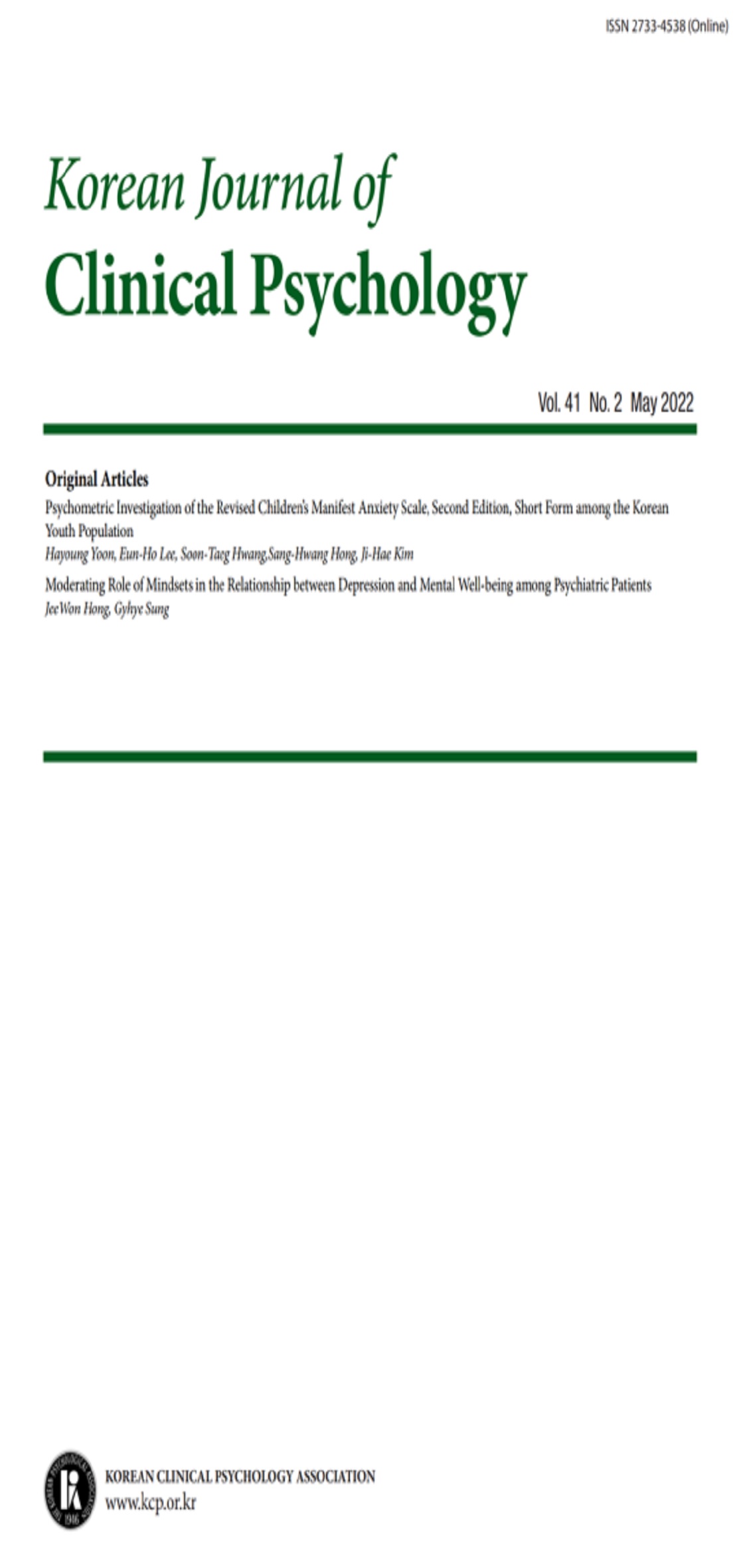open access
메뉴
open access
메뉴 E-ISSN : 2733-4538
E-ISSN : 2733-4538
본 연구는 특질 불안과 억압성격이 기본적 정서 특질을 유지시키는 기억 특징을 알아보고자 하였다. 이를 위해 위협 단어와 비위협 단어에 대하여 암묵기억과 외현기억을 측정하는 지각식별검사와 자유회상검사를 실시하여 집단 간의 수행차이를 관찰하였다. 연구 결과 지각식별과제에서 고불안 집단이 저불안 집단보다 위협단어에 대한 점화량이 유의하게 많았고, 자유회상에서는 두 집단 간에 위협단어 회상량의 차이가 없었다. 그리고 지각식별과제에서 억압 집단이 저불안 집단보다 점화량이 유의하게 많았고, 자유회상에서는 두 집단간에 회상량의 차이가 없었다. 이것은 고불안자는 정보처리단계 초기에는 자동적으로 부정적인 정보에 주의를 기울이지만, 후기 단계에서는 부정적인 정보를 의도적으로 회피함을 시사한다. 이러한 인지적 회피전략은 불안 증상을 더욱 악화시키는 역할을 한다. 아울러 억압자도 불안과 관련된 자극이 자동적으로 활성화된다는 것을 확인하였다. 이러한 결과는 불안 집단과 억압자의 인지과정 뿐 아니라 치료적 접근에도 많은 시사점을 제공하고 있다.
The primary purpose of this study was to investigate the striking memories of high-trait anxiety subjects and repressor, who maintain their own emotional trait inside. In order to achieve this goal, each subjects conducted a perceptual identification and free recall task on threatening and non-threatening words, and the scores were compared among three groups. Results indicated that high anxious subjects reveal significantly higher priming on threat words than low anxious subjects in perceptual identification task, but the differences of free-recall between these group is not significant. In addition, repressor revealed significantly higher priming on threat words than low anxious subjects in perceptual identification task. But they didn't show significantly higher recall on non-threatening words in free recall task. This suggests that high anxiety group respond automatically to threat cues in the initial stage of information processing, but intentionally avoid negative stimulus in the later stage of information processing. Such cognitive avoidance strategy serves to exacerbate anxiety symptoms. Furthermore, it was confirmed that repressors automatically activate anxiety- relevant stimuli. In conclusion, the present study provides many suggestions to the approach in the treatment of high-trait anxiety subjects and repressors.
(1989) 불안집단의 편파적 인지성향,
(1995) 정신병리와 인지Ⅰ: 정서장애를 중심으로,
(1996) 처리 깊이에 따른 학습단어의 반복제시가 단어 완성 검사와 단서 회상 검사에 미치는 효과,
(2001) 사회공포증 하위유형의 기억편향,
(1997) 불안과 우울이 암묵기억과 외현기억에 미치는 영향,
(2000) 강박사고 억제의 역설적 효과,
(1996) 특질불안과 주의편향간의 관계,
(1996) Spielberger의 상태-특성 불안검사 Y형의 개발,
(1983) Differentiation between low anxiety and repression of anxiety by autonomic-facial-verbal pattern of behavior Journal of Personality and Social Psychology, The discrepant Repressor
(2003) Coping style and threat processing,
(1979) Cognitive therapy of depression, Guilford Press
(1978) Dimensions of personality, Repression- Sensitization
(1989) Investigating dissociations among memory measures Support for a transfer-appropriate processing framework Journal of Experimental Psychology,
(1997) Repressive coping: Distraction Using Pleasant Thoughts and Memories.,
(1981) Mood and memory,
(1983) Negative self-schemata in clinical depression British Journal of Clinical Psychology,
(1961) Conception of perceptual defense,
(1999) Recall and recognition of threatening, pleasant, and neutral words in repressors.,
(1963) Relations of the revised Repression-Sensitization Scale to measures of self-description,
(1985) Constraints on the effects of mood on memory Journal of Personality and Social Psychology,
(1982) Psychological factors and psychophysiological mechanisms in the etiology and development of cancers,
(1964) Studies in evaluative dependence,
(1996) Repressive coping style and the experience and recall of emotion: a naturalistic study of daily affect.,
(1987) Repression and the inaccessibility of affective memories,
(1990) Repression and the inaccessibility of emotional memories The University of Chicago Press, Repression and Dissociation
(1981) Schematic processing and self-reference in clinical depression,
(1997) Anxiety and cognition: a unified theory, London: Erlbaum.
(1987189-195) Cognitive functioning in anxiety,
(1991) Bias in interpretation of ambiguous sentences related to threat in anxiety Journal of Abnormal Psychology,
(1986) Exposure to corrective information,
(1985) The role of emotional expression Journal of Personality and Social Psychology,
(1967) Factor analytic study of the Manifest anxiety Journal of Consulting Psychology, and Repression- Sensitization Scales
(1984) Journal of Verbal Learning and Verbal Behavior,
(1988) Repression of emotionally tagged memories The architecture of less complex emotions Journal of Personality and Social Psychology,
(1992) Repressive at encoding discrete appraisals of emotional stimuli Journal of personality and Social Psychology,
(1972) Processing of the 80th Annual Convention of the American Psychological Association, Repression-Sensitization
(1981) On the relationship between autobiographical memory and perceptual learning,
(1991) Ambulatory blood pressure and heart rate in paramedics Effect of cynical hostility and defensiveness,
(1971) Anxiety report in defensive and nondefensive repressors Journal of Consulting and Clinical Psychology,
(1999) Repression and coping with the threat rape,
(1986) Attentional bias in emotional disorders Journal of Abnormal Psychology,
(1992) Anxiety and the selective processing of emotional information Mediating roles of awareness and personal relevance of stimulus materials,
(1994) Cognitive approach to emotion and emotional disorders Annual Review of Psychology,
(1989) Implicit and explicit memory bias in anxiety Journal of Abnormal Psychology,
(1989) Memory bias for anxiety information in patients with panic disorder,
(1987) Memory bias in clinical anxiety Journal of Abnormal Psychology,
(1977) Levels of processing versus transfer appropriate processing Journal of Verbal Learning and Verbal Behavior,
(1994) Recall of experience and the repressed coping style Journal of Abnormal Psychology, & Brewin C
(1995) Repressive coping and the recall of emotional material,
(1999) Repressive coping and the inaccessibility of negative autobiographical memories: converging evidence,
(1994) The effect of high and low trait anxiety on implicit and explicit memory tasks,
(2002) Explicit and implicit memory, trait anxiety, and repressive coping style,
(1920) Expression of emotions in cases of mental disorders,
(1997a) Anxiety and memory: A recall bias for threatening words in high anxiety,
(1997b) A memory bias for threat in high-trait anxiety,
(1991) Effect of encoding and anxiety on implicit and explicit memory performance,
(1989) Colour- identification of differentially valenced words in anxiety,
(1990) Implicit memory:A commentary,
(1987) Retrieval modes produce dissociations in memory for surface information, Lawrence Eerlbaum Association Inc
(1983) Manual for the State-Trait Anxiety Inventory, Consulting Psychologists Press
(1979) psychometric patterns and behavioral and physiological response to stress Journal of Abnormal Psychology, and repressive coping styles
